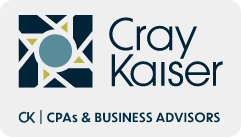Member of Russell Bedford International, a global network of independent professional service firms.
Accounting
Audio Blogs
Audits
Business Valuation
Family Business
News
Nonprofit
Operations & Strategy
Retirement
Taxes
Team
Videos
Whitepapers
All About an Accounting Internship at CK
Tips to Bring Sanity to Your Year-End Financial Reporting Process
3 Approaches to Business Valuation
Happy International Women’s Day from Cray Kaiser!
Fair Market Value and Fair Value in Business Valuations
Understanding State Sales Tax, Nexus and Voluntary Disclosure Programs
Update on the Pending Smith-Wyden Tax Act
Exploring State Tax Incentives That Can Benefit Your Business
Tapping into Cray Kaiser’s Accounting Services Division for Your Outsourced Accounting Needs
Insights into the Corporate Transparency Act
Natalie McHugh Announced as CK’s Newest Principal
Cray Kaiser Employee Spotlight: Steve Benzinger




